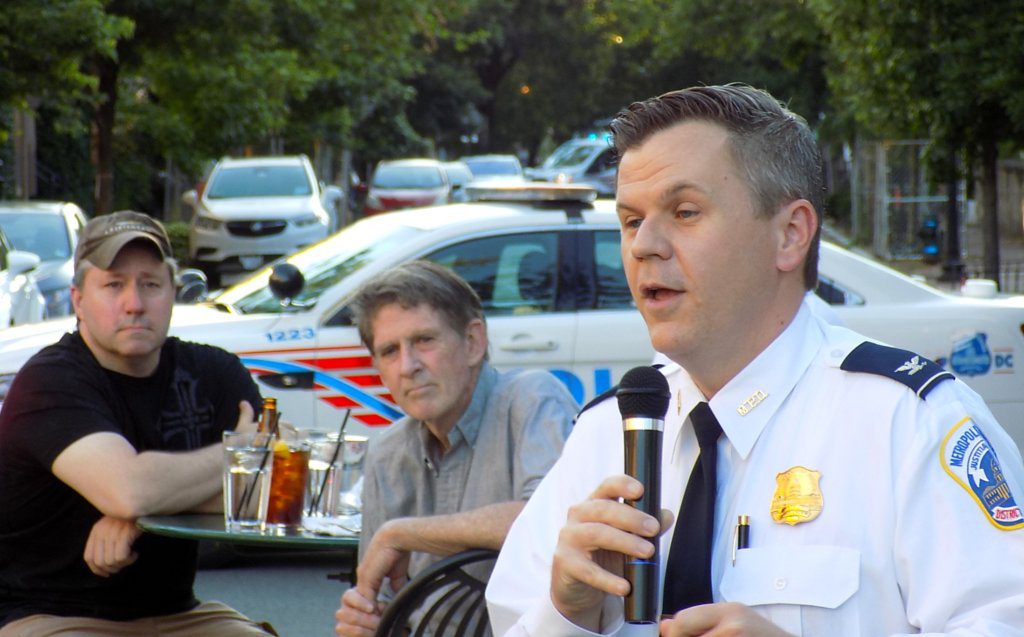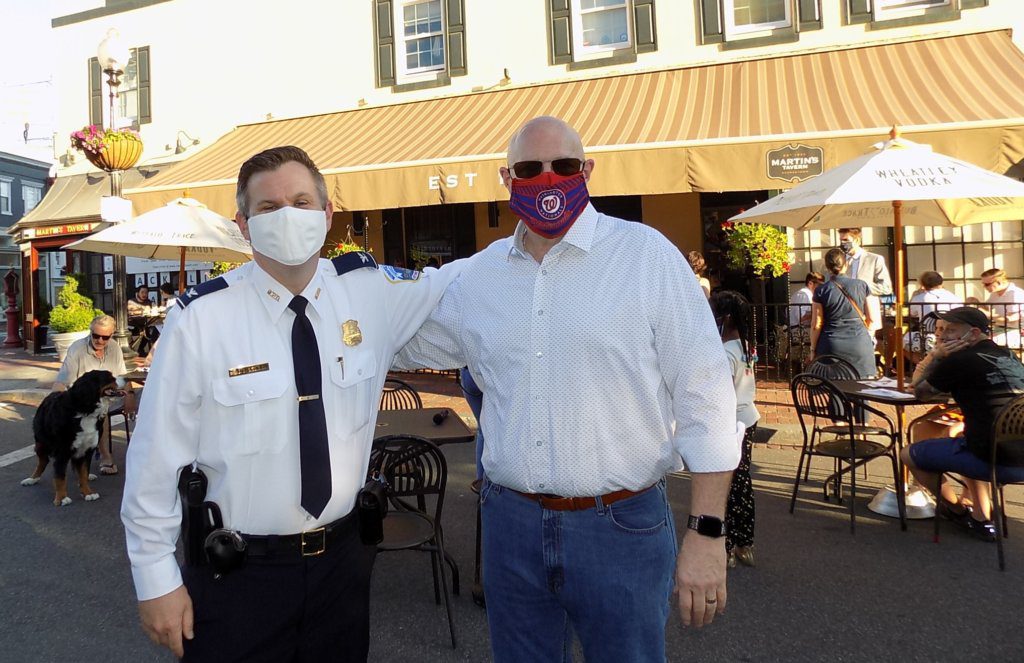Police Hold Street Meeting About Georgetown Looting
By • June 8, 2020 0 1524

It felt like a mild summer evening on June 7 when Second District Cmdr. Duncan Bedlion of the Metropolitan Police Department held a hastily organized meet-and-greet in Georgetown on N Street at the corner of Wisconsin Avenue. The meeting was hosted by Martin’s Tavern owner Billy Martin.
On June 3, the corner in front of Martin’s had been the site of a massive sit-down, with hundreds of people protesting the May 25 death of George Floyd while forcibly restrained by Minneapolis police officers who have now been charged. Many of the protestors in Georgetown that night, chanting “Black Lives Matter” and “This is what democracy looks like,” were dressed all in black. Up and down Wisconsin Avenue from where they sat, almost all the stores and businesses had been boarded up in the wake of vandalism and looting that took place on May 30 and 31.
The looting had not been expected. Georgetown’s streets were deserted following a timid first day of Phase One reopening after three months of pandemic lockdown. “Only a few police officers had been present in Georgetown those nights,” Bedlion said. “Instead, the entire District force … were deployed to the downtown area, where thousands of demonstrators had gathered in Lafayette Park in front of the White House.”
But on this Sunday evening, a week later, there was palpable mood of relief and a desire to know what was happening. This weekend had passed peacefully, with thousands of people (not the predicted one million) assembling on a portion of 16th Street NW blazoned with the words BLACK LIVES MATTER and in front of the Lincoln Memorial — watched over by National Guard soldiers and Metropolitan Police officers on standby. There had been no violence for five days.
The demands of protesters were evolving — from justice for Floyd to demands to reform and even to “defund” police departments.
“It is time to talk about it,” Bedlion told the assembled crowd of Georgetown residents, advisory neighborhood commissioners, restaurant patrons eating at tables set up on the street and a mix of police captains, detectives and patrol officers. “What happened in Minneapolis was nothing short of murder. The inaction of the law enforcement officers there to stop the murder is against every policy, regulation and training of the D.C. MPD. That would not be allowed here.”
Instead, Bedlion praised his “incredible police force” for their restraint in face of crowds assaulting them verbally and with firecrackers, bricks and gunshots. Between Friday and Monday, 25 people were arrested, most of them D.C. residents, he said. But he admitted that the police had failed to protect Georgetown businesses because their numbers were few and most were deployed elsewhere.
“When can we take the boards down from our storefronts?” one Georgetown businessman asked.
“Everyone now is fully activated on a rolling basis,” Bedlion said. “It’s up to business owners. We’re now seeking public assistance in identifying multiple persons and vehicles of interest in reference to criminal offenses during that time.” He noted that the department had obtained photo and video footage of numerous individuals committing crimes in Georgetown and other parts of D.C. MPD is asking the public to review the videotapes and offering a reward of up to $1,000 for information leading to the arrest and indictment of those responsible.
“Why are you here?” asked one youth who had grown up in Georgetown and now lives in New York City. “Why are you talking to rich white people in the most wealthy area of Washington, D.C.? Why are you criminalizing poverty and homelessness?”
“That’s my beat,” responded Detective Rachel Pulliam. “Your concern and enthusiasm is welcome. Why don’t you come back to D.C. and work with us on the many programs that D.C. and so many organizations support for D.C. residents?” The questioner thanked Pulliam for her response.

Second District Cmdr. Duncan Bedlion of the Metropolitan Police Department with Martin’s Tavern owner Billy Martin on N Street on June 7. Georgetowner photo.

